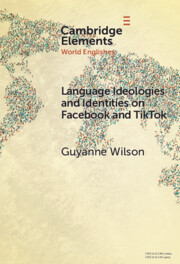Element contents
Language Ideologies and Identities on Facebook and TikTok
Published online by Cambridge University Press: 17 May 2024
Summary
Keywords
Information
- Type
- Element
- Information
- Series: Elements in World EnglishesOnline ISBN: 9781009350808Publisher: Cambridge University PressPrint publication: 06 June 2024
